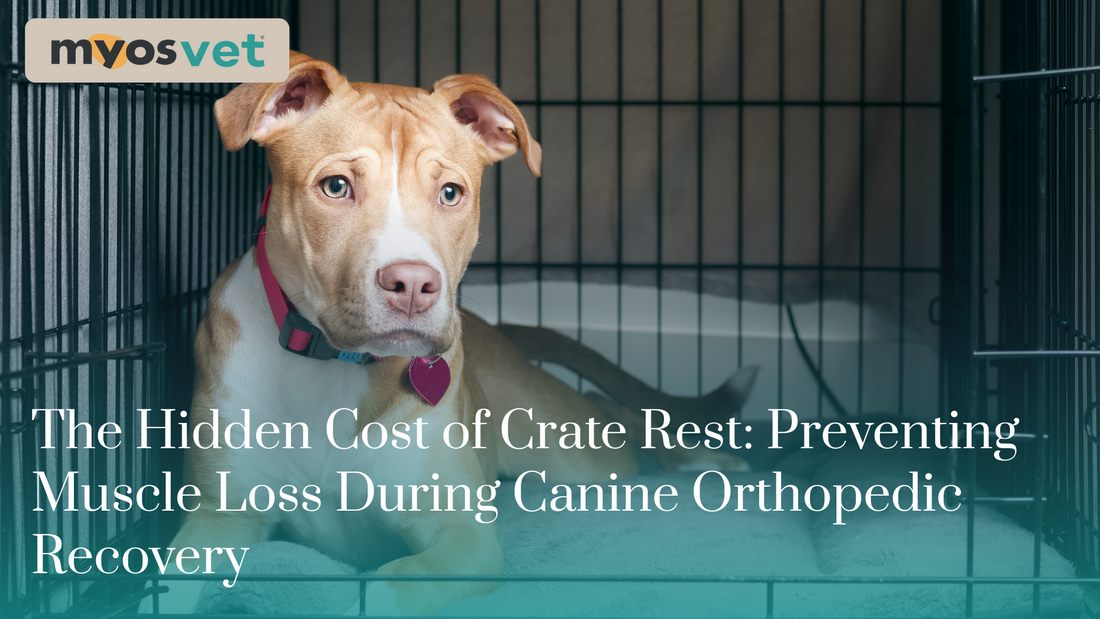
The Hidden Cost of Crate Rest: Preventing Muscle Loss During Canine Orthopedic Recovery
Share
When a dog undergoes orthopedic surgery—whether for a cruciate ligament rupture, luxating patella, or spinal stabilization—prescribing crate rest is often non-negotiable. Immobilization is necessary to protect healing tissues and prevent further injury. But with reduced mobility comes a predictable downside: muscle atrophy.
While we focus on joint stabilization and bone healing, muscle loss can begin within days of inactivity, threatening long-term mobility, extending recovery timelines, and increasing the risk of re-injury. As veterinary professionals, it’s our job to help clients understand that crate rest doesn’t have to mean total passivity. There are practical, low-risk ways to mitigate muscle wasting even during strict confinement.
Understanding the Timeline of Atrophy
Muscle disuse leads to measurable loss of mass and strength within 7–10 days of inactivity. For older patients or those already under-conditioned prior to surgery, the consequences can be even more dramatic. In some cases, owners report that their pet seems "frail" or "slower" than before surgery—not because of the orthopedic injury itself, but because of significant muscle loss during recovery.
Risk Factors That Exacerbate Atrophy During Crate Rest
- Age-related sarcopenia (natural muscle loss in older dogs)
- Poor baseline body condition
- Inadequate dietary protein or caloric intake
- Delayed initiation of rehab therapy
- Lack of passive or assisted movement
Interventions to Support Muscle Health During Crate Rest
While full exercise is restricted, several safe and effective strategies can be implemented to support muscle preservation:
1. Nutritional Support
Recovery demands an increased need for high-quality protein and anabolic support. Incorporating muscle-supportive nutrition—such as MYOS Canine Muscle Formula made with Fortetropin®—can help reduce muscle atrophy and support the body’s natural muscle-building processes.
Fortetropin, a natural bioactive made from fertilized egg yolk, has been shown to reduce myostatin, a protein that inhibits muscle growth. Administering it during periods of immobility may help preserve muscle integrity, especially when rehab is delayed or restricted.
2. Passive Range of Motion (PROM) Exercises
Performed gently and under veterinary guidance, PROM helps maintain joint flexibility and mild muscle engagement without violating activity restrictions. Owners can be trained to safely perform these at home when appropriate.
3. Neuromuscular Electrical Stimulation (NMES)
For dogs under the care of a rehabilitation specialist, NMES can stimulate muscle contractions even in immobilized limbs. This helps prevent atrophy and maintain neuromuscular connections while activity is restricted.
4. Massage and Therapeutic Touch
Soft tissue massage increases circulation, reduces stiffness, and may help relieve discomfort. While it doesn't replace exercise, it contributes to overall well-being and may support muscle health.
5. Mental Stimulation and Controlled Movement
Interactive feeding tools or short leash-assisted potty walks (when approved) provide mild physical activity and prevent complete physical and cognitive stagnation.
Helping Pet Owners Understand the Big Picture
Crate rest can be emotionally difficult for pet owners. Educating them on the importance of muscle preservation during recovery adds value to the surgical outcome and emphasizes a more holistic, long-term view of their pet’s health. Provide a muscle monitoring plan that includes body weight, body condition score (BCS), and Muscle Condition Score (MCS) to make progress visible and trackable.
Conclusion
Crate rest is essential, but so is muscle preservation. With nutritional interventions like Fortetropin, passive therapies, and early-stage muscle support, veterinary professionals can help dogs maintain strength and bounce back from orthopedic surgery with greater resilience. By addressing the hidden cost of crate rest, we set our patients up for a fuller, stronger recovery.
